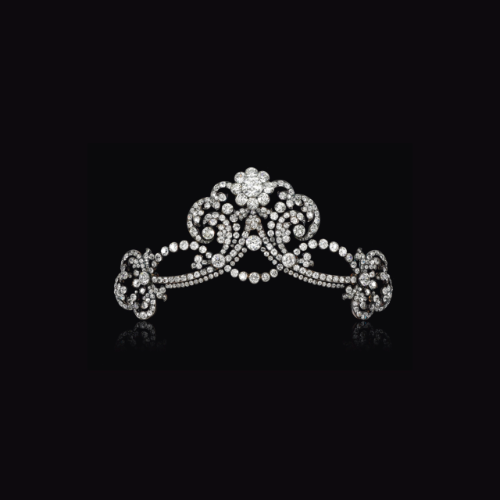
Posted in: Jewelry History, Auctions/Results
 Diamond tiara, Köchert, circa 1901. Photo courtesy Sotheby's.
This gorgeous diamond tiara was designed by the House of Köchert in 1901. Made as a gift from the Emperor of Austria to his great-niece the Archduchess Maria Anna of Austria, it recently sold for more than $251,000 at Sotheby's.
The Köchert tiara featured prominently as part of Sotheby's Royal Jewels of the Bourbon Parma Family auction held on November 14th. Sotheby's described it as a small tiara, or bandeau, made by the esteemed jewelers and accompanied by a beige leather case. They confirmed that it was given to the Archduchess by her great-uncle as a wedding gift.
Diamond tiara, Köchert, circa 1901. Photo courtesy Sotheby's.
This gorgeous diamond tiara was designed by the House of Köchert in 1901. Made as a gift from the Emperor of Austria to his great-niece the Archduchess Maria Anna of Austria, it recently sold for more than $251,000 at Sotheby's.
The Köchert tiara featured prominently as part of Sotheby's Royal Jewels of the Bourbon Parma Family auction held on November 14th. Sotheby's described it as a small tiara, or bandeau, made by the esteemed jewelers and accompanied by a beige leather case. They confirmed that it was given to the Archduchess by her great-uncle as a wedding gift.
Archduchess Maria Anna
Maria Anna was born in January 1882, in Austria-Hungary. She belonged to the Teschen branch of the House of Habsburg-Lorraine, a royal family famous for their love of diamonds. By birth, she held the title of Archduchess of Austria, as well as the title of Princess of Bohemia, Hungary, and Tuscany. Upon her marriage to Prince Elias of Bourbon-Parma in 1902, Maria Anna added the title of Princess of Bourbon-Parma to her repertoire. Sadly, all of Prince Elias's siblings were declared mentally incompetent. In their stead, he served as regent for the ducal claims of Parma. He also held guardianship of his five disabled siblings. Held in esteem by Emperor Franz Joseph of Austria, he entered the Order of the Golden Fleece as a knight in 1907. His marriage to Maria Anna resulted in eight children, only one of whom married. Their daughter Infanta Alicia of Spain, Duchess of Calabri had three children. She died in 2017, in Madrid. On her wedding day, Alicia's mother, the Archduchess of Austria, wore the Köchert tiara as a choker.An Exquisite Tiara
This beautiful petite choker features a stunning array of pave-set, collet-set, and round-cut white diamonds. The central cluster, as well as the side motifs are detachable. The foliate design culminates with a central sweeping affair that resembles an Art Deco-style plume. Given that the tiara was made 20 years before this era begins, one wonders if its designers at Köchert could be called tastemakers.Pioté et Köchert
Indeed, Köchert served as tastemakers for the European scene for decades. The history of this esteemed jeweler begins with a goldsmith's workshop in Vienna. Owned by a Frenchman, Emanuel Pioté, this shop gains renown for its techniques in gold and enamel. In time, a Baltic German applies to work with Pioté. Jakob Heinrich Köchert learned the skill of setting large pieces of jewelry during his apprenticeship in St. Petersburg. Over the next decade, Emanuel and Jakob fashion spectacular jewels which blend French, Russian, and Austrian styles. Their designs captivate the attention of the Austrian Emperor, Joseph Franz I. In 1831, the Emperor commissions the duo to create a gold box as a gift for the Turkish Ambassador. The following year, the Emperor of Austria bestows upon them the esteemed title of Imperial and Royal Court Jeweller. In the meantime, Jakob marries Emanuel's sister-in-law. Now connected in business and family, their partnership blossoms into Pioté et Köchert. In 1844, Jakob's son Alexander Emanuel joins the company. Experts credit Alexander with taking the atelier beyond its borders, establishing it as one of the leading jewelers in Europe.The House of Köchert
Emanuel's involvement seems to slip into oblivion, and at some point unknown to me the House of Köchert stands alone. Upon his father's death, Alexander applies for and receives the title of Royal Jeweler, a title the family holds onto until the empire dissolves in 1918, at the end of World War I. Although this marked the end of Habsburg rule, Köchert continued supplying sophisticated jewels to the royals and nobles of Europe. In 1880, Alexander's sons Heinrich and Theodor take over the company. After that, in 1922, Theodor's sons Erich and Wilfried assume the reigns. At the present time, Christoph, Wolfgang, and Florian, representing the 7th generation of the Köchert family, continue producing distinctive pieces in their ancestral workshops in Vienna.5 years ago
3 view(s) 